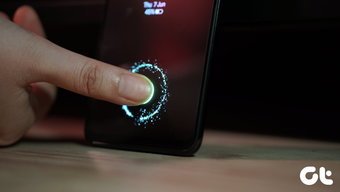For one, Google built the scanner right inside Drive instead of going for a separate app. Let’s dive deeper and see which approach is better, and which scanner app should you prefer over the other.
1. How to Scan
Because scanner is part of Google Drive app, you will have to open Drive and click on the ‘+’ icon to begin. There is a widget that you can place on the homescreen though. On the other hand, the camera will automatically launch in Office Lens when you open the app. That’s one less click and works much faster.
2. Scanning Options
This is where things begin to differ significantly. Microsoft Office Lens takes a more professional approach and offers 4 different options, namely Whiteboard, Document, Business Card, and Photo. Choosing one will change brightness and contrast settings to remove glare and bring things into more focus. Each self-explanatory, giving the user more control over scanning options. Google Drive Scan also offers scanning options but they are different. Photo, Portrait, Square, and Manual. Personally, I find Office Lens’ approach better where depending on the type of document I am scanning, the app will apply settings automatically. Makes more sense. For example, when you are scanning a whiteboard, there are chances of glare. Office Lens handles it beautifully though by removing shadows, glare, and turning off flash.
3. Multipage Scans
Office Lens detects the edges automatically. There is a bulk mode option at the upper right to scan multiple pages at once. Once you enable it, you can scan one page after another without having to go back and forth between editing options. Once you are done scanning all the pages, tap on the circular scan option on the right with a number denoting the number of scans completed. Simply tap on the orange check mark option to create a PDF file with all the scans neatly organized page-wise. You will select the PDF option in the next screen. Drive Scan failed to identify the corners leading to unnecessary cropping. But there was an option to manually adjust it. Coming back to multipage scanning, there is a ‘+’ icon to scan another page, however, you have to tap on it repeatedly to go back to scanning mode. Office Lens is a lot faster because once bulk mode is selected, you can simply scan one page after another. Drive Scan also creates a PDF file like Office Lens and, in both the apps, each document is saved in a new page.
4. Editing Options
Scanning documents is not the only option available at your disposal in Office Lens. Once you are done scanning, there are options to add text, annotate, rotate image, and change scan type. They are very easy to use and work really well. Useful for highlighting important text or annotating important parts of the document. Unfortunately, Google Drive Scan misses out on all these useful and much needed features. Instead, there are image enhancement features like ability to turn pages black & white or use color. Another thing I noted is that every scan is timestamped in Drive Scan. There is an option to remove timestamp and device watermark in the settings though, thankfully. Where Drive Scan has image enhancement options, Office Lens has resolution options. You can go from 2.1M in 1920x1080p and all the way to 12M at 4000x3000p. All screenshots in this guide were taken at 3.1M option, so there is quite a lot of room for improvement.
5. Sharing Options and OCR
Needless to say, both Office Lens and Drive Scan prefer their own ecosystem over others. Office Lens can save scans to the Gallery, as a PDF file, to OneNote note-taking app, as Word and PowerPoint file or save it to the cloud using OneDrive. All Microsoft Office apps. Notice the Immersive Reader option? That’s pretty cool. You see, Office Lens comes with powerful OCR and text to voice capabilities which means the app can read out the scanned text for you. You can manage the volume as well as speaking rate, if you are a fast listener. It was 100% accurate during my tests which is almost magical! Google Drive Scan will simply create a PDF file and upload it to a Drive folder of your choice. You will need a third-party PDF editor like Xodo to edit or mark the PDF file. Where Office Lens can save the scanned document directly in one or more Office 365 formats, you have to open the saved file manually in Google Docs or Sheets app. After that, you can edit the document. Again, more unnecessary steps involved. On the plus side, once the PDF file is saved to Google Drive, you can search for the printed text using Drive’s universal search. So, OCR does work in Google Drive but there is no text to voice feature.
And the Winner is …
Office Lens wins hands down. It is extremely easy and quick to use, comes with a robust set of editing options, detects a variety of documents like cards, whiteboard and more with ease, and you can save it in a number of formats to different Office apps. Even if you are not using Microsoft Office, there is always the Gallery and PDF option. Drive Scan seems like an afterthought built into Google Drive rather than a full-fledged scanning app. Useful for quick and casual scans but that’s how far it goes. Both are free and available on Android and iOS. Next up: Want to learn more about Google Drive Scan and how it works with different apps? Click on the link below to know more. The above article may contain affiliate links which help support Guiding Tech. However, it does not affect our editorial integrity. The content remains unbiased and authentic.






























